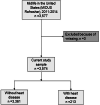Relationship Between Heart Disease and Obesity Indicators Among Adults: A Secondary Data Analysis
- PMID: 37123803
- PMCID: PMC10132081
- DOI: 10.7759/cureus.36738
Relationship Between Heart Disease and Obesity Indicators Among Adults: A Secondary Data Analysis
Abstract
Background Body mass index (BMI), waist circumference (WC), and hip circumference (HC) determine obesity. Several studies have examined the association between obesity and many diseases, including heart disease, and found it to be a substantial risk factor. However, the relationship between heart disease and obesity has not been investigated. This study investigated the relationship between heart disease and obesity indicators among adults encompassing sociodemographic and lifestyle factors. Methodology This cross-sectional study included data from 3,574 individuals who participated in the 2011-2014 National Survey of Midlife Development in the United States refresher. The presence or absence of heart conditions such as irregular heartbeat, heart murmur, heart attack, and heart failure was determined using self-reported questionnaires. The association between heart disease and obesity indicators such as BMI, WC, HC, and waist-to-hip ratio (WHR) was investigated using linear regression. Results After controlling for all factors, the findings demonstrated a significant relationship between heart disease and BMI, WC, and HC high scores of 1.12 kg/m2, 0.63 inches, and 0.81 inches, respectively. A higher score in all obesity indicators was linked to being 65 years or older; male gender (for HC); having a school/college level of education; being unmarried, divorced, or widowed; having a history of smoking; and avoiding alcohol use. Conclusions Heart disease and sociodemographic and lifestyle factors are substantially associated with a high score in all obesity indicators. The findings of this study are important because they can assist healthcare providers in implementing different therapies to prevent high BMI, WC, HC, and WHR.
Keywords: heart disease; lifestyle; obesity; sociodemographic; waist.
Copyright © 2023, Alwadeai et al.
Conflict of interest statement
The authors have declared that no competing interests exist.
Figures
References
-
- Heart disease and stroke statistics-2019 update: a report from the American Heart Association. Benjamin EJ, Muntner P, Alonso A, et al. Circulation. 2019;139:0. - PubMed
-
- The global burden of cardiovascular diseases and risk factors: 2020 and beyond. Mensah GA, Roth GA, Fuster V. J Am Coll Cardiol. 2019;74:2529–2532. - PubMed
-
- Heart disease and stroke statistics-2021 update: a report from the American Heart Association. Virani SS, Alonso A, Aparicio HJ, et al. Circulation. 2021;143:0–743. - PubMed
LinkOut - more resources
Full Text Sources


